教案3-形容词副词
教案(形容词,副词)
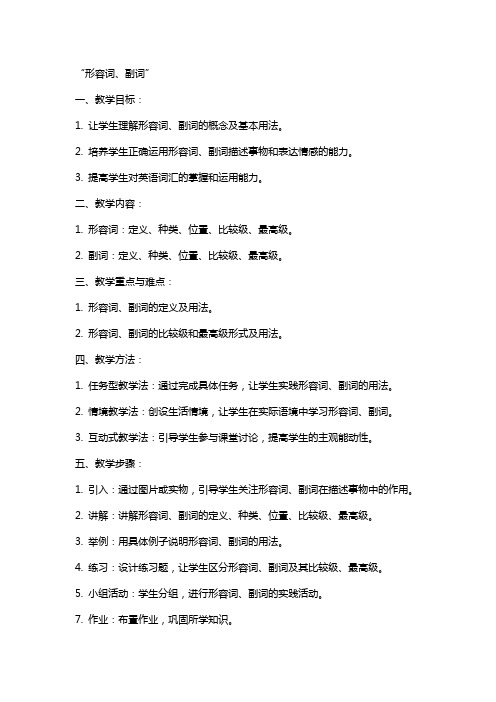
“形容词、副词”一、教学目标:1. 让学生理解形容词、副词的概念及基本用法。
2. 培养学生正确运用形容词、副词描述事物和表达情感的能力。
3. 提高学生对英语词汇的掌握和运用能力。
二、教学内容:1. 形容词:定义、种类、位置、比较级、最高级。
2. 副词:定义、种类、位置、比较级、最高级。
三、教学重点与难点:1. 形容词、副词的定义及用法。
2. 形容词、副词的比较级和最高级形式及用法。
四、教学方法:1. 任务型教学法:通过完成具体任务,让学生实践形容词、副词的用法。
2. 情境教学法:创设生活情境,让学生在实际语境中学习形容词、副词。
3. 互动式教学法:引导学生参与课堂讨论,提高学生的主观能动性。
五、教学步骤:1. 引入:通过图片或实物,引导学生关注形容词、副词在描述事物中的作用。
2. 讲解:讲解形容词、副词的定义、种类、位置、比较级、最高级。
3. 举例:用具体例子说明形容词、副词的用法。
4. 练习:设计练习题,让学生区分形容词、副词及其比较级、最高级。
5. 小组活动:学生分组,进行形容词、副词的实践活动。
7. 作业:布置作业,巩固所学知识。
六、教学拓展:1. 形容词、副词的搭配:让学生了解形容词、副词与名词、动词的搭配用法,提高语言表达能力。
2. 形容词、副词的修饰顺序:讲解形容词、副词修饰名词或动词的顺序,提高句子表达的准确性。
七、教学评估:1. 课堂参与度:观察学生在课堂讨论、实践活动中的表现,评估其对形容词、副词的掌握程度。
2. 练习题答案:批改练习题,了解学生对形容词、副词知识的掌握情况。
3. 小组活动:评估学生在小组活动中的表现,关注其团队合作能力和语言运用能力。
八、教学反馈:1. 学生反馈:听取学生对课堂内容的意见和建议,以便改进教学方法。
2. 自我反思:教师课后反思教学效果,针对不足之处进行调整。
九、教学延伸:1. 家庭作业:布置相关形容词、副词的练习题,巩固所学知识。
2. 课后阅读:推荐相关文章或书籍,拓展学生的词汇量和语言运用能力。
形容词副词教案
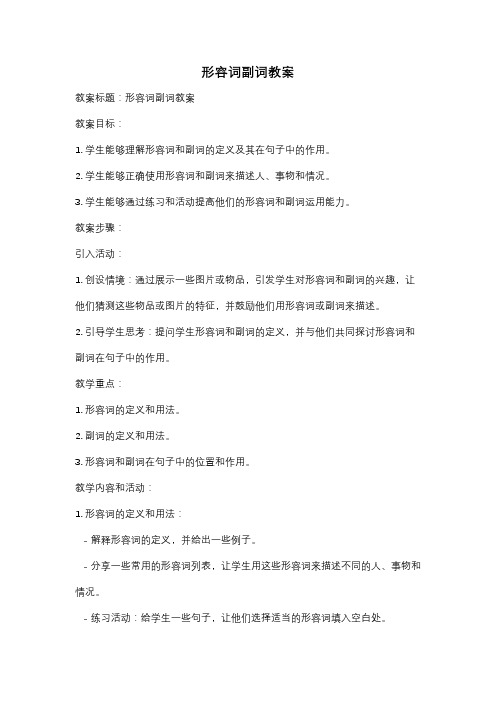
形容词副词教案教案标题:形容词副词教案教案目标:1. 学生能够理解形容词和副词的定义及其在句子中的作用。
2. 学生能够正确使用形容词和副词来描述人、事物和情况。
3. 学生能够通过练习和活动提高他们的形容词和副词运用能力。
教案步骤:引入活动:1. 创设情境:通过展示一些图片或物品,引发学生对形容词和副词的兴趣,让他们猜测这些物品或图片的特征,并鼓励他们用形容词或副词来描述。
2. 引导学生思考:提问学生形容词和副词的定义,并与他们共同探讨形容词和副词在句子中的作用。
教学重点:1. 形容词的定义和用法。
2. 副词的定义和用法。
3. 形容词和副词在句子中的位置和作用。
教学内容和活动:1. 形容词的定义和用法:- 解释形容词的定义,并给出一些例子。
- 分享一些常用的形容词列表,让学生用这些形容词来描述不同的人、事物和情况。
- 练习活动:给学生一些句子,让他们选择适当的形容词填入空白处。
2. 副词的定义和用法:- 解释副词的定义,并给出一些例子。
- 分享一些常用的副词列表,让学生用这些副词来描述不同的动作和情况。
- 练习活动:给学生一些句子,让他们选择适当的副词填入空白处。
3. 形容词和副词在句子中的位置和作用:- 解释形容词和副词在句子中的位置和作用,并给出一些例子。
- 练习活动:给学生一些句子,让他们判断形容词和副词在句子中的位置和作用。
总结和评估:1. 总结形容词和副词的定义和用法,并强调它们在句子中的作用。
2. 给学生一些练习题,以评估他们对形容词和副词的理解和应用能力。
3. 鼓励学生在日常生活中多使用形容词和副词来描述事物和情况。
拓展活动:1. 让学生在小组中创作一个故事,要求他们使用尽可能多的形容词和副词来描述故事中的人物和情景。
2. 给学生一些句子,让他们根据句子中的描述画出对应的图画,并分享他们的作品。
教学资源:1. 图片或物品,用于引入活动。
2. 形容词和副词的列表,用于练习活动。
3. 练习题和评估材料。
教案(形容词,副词,介词)

形容词、副词、介词一、形容词1. 教学目标:(1)让学生理解形容词的概念和作用;(2)培养学生正确使用形容词描述事物的能力;(3)引导学生区分形容词的比较级和最高级。
2. 教学内容:(1)形容词的定义和用法;(2)形容词的比较级和最高级;(3)形容词在句子中的位置。
3. 教学步骤:(1)引入形容词的概念,举例说明;(2)讲解形容词的比较级和最高级的构成及用法;(3)通过练习题让学生巩固所学知识;(4)布置作业,让学生运用形容词描述事物。
二、副词1. 教学目标:(1)让学生理解副词的概念和作用;(2)培养学生正确使用副词修饰动词、形容词或其他副词的能力;(3)引导学生区分副词的比较级和最高级。
2. 教学内容:(1)副词的定义和用法;(2)副词的比较级和最高级;(3)副词在句子中的位置。
3. 教学步骤:(1)引入副词的概念,举例说明;(2)讲解副词的比较级和最高级的构成及用法;(3)通过练习题让学生巩固所学知识;(4)布置作业,让学生运用副词修饰动词、形容词或其他副词。
三、介词1. 教学目标:(1)让学生理解介词的概念和作用;(2)培养学生正确使用介词表示时间、地点、方向等关系的能力;(3)引导学生区分介词的用法和搭配。
2. 教学内容:(1)介词的定义和用法;(2)常见介词的表示时间、地点、方向等关系;(3)介词的搭配及注意事项。
3. 教学步骤:(1)引入介词的概念,举例说明;(2)讲解常见介词的用法和搭配;(3)通过练习题让学生巩固所学知识;(4)布置作业,让学生运用介词表示时间、地点、方向等关系。
四、形容词、副词、介词在句子中的位置1. 教学目标:(1)让学生了解形容词、副词、介词在句子中的不同位置;(2)培养学生正确摆放形容词、副词、介词的能力;(3)引导学生运用形容词、副词、介词丰富句子表达。
2. 教学内容:(1)形容词、副词、介词在句子中的位置;(2)形容词、副词、介词的搭配及用法;(3)通过实例分析,让学生掌握形容词、副词、介词的运用技巧。
教案(形容词副词)

教案(形容词副词)第一章:形容词和副词的概念与分类1.1 形容词的概念与作用解释形容词的定义说明形容词在句子中的作用举例说明形容词的使用1.2 副词的概念与作用解释副词的定义说明副词在句子中的作用举例说明副词的使用1.3 形容词和副词的分类描述形容词和副词的分类及特点举例说明不同类别的形容词和副词第二章:形容词和副词的构成与变化2.1 形容词的构成解释形容词的构成方式举例说明形容词的构成方法2.2 副词的构成解释副词的构成方式举例说明副词的构成方法2.3 形容词和副词的变化说明形容词和副词在不同语态和时态中的变化规则举例说明形容词和副词的变化形式第三章:形容词和副词的用法3.1 形容词的用法说明形容词在句子中的位置和修饰对象举例说明形容词的常见用法3.2 副词的用法说明副词在句子中的位置和修饰对象举例说明副词的常见用法3.3 形容词和副词的比较级和最高级解释形容词和副词的比较级和最高级的概念和用法举例说明形容词和副词的比较级和最高级的构成和用法第四章:形容词和副词在句子中的搭配4.1 形容词和副词与名词的搭配说明形容词和副词与名词的搭配关系举例说明形容词和副词与名词的搭配用法4.2 形容词和副词与动词的搭配说明形容词和副词与动词的搭配关系举例说明形容词和副词与动词的搭配用法4.3 形容词和副词与其他词类的搭配说明形容词和副词与其他词类的搭配关系举例说明形容词和副词与其他词类的搭配用法第五章:形容词和副词的练习与应用5.1 形容词和副词的填空练习提供一些填空题,让学生根据句意和语法规则填入适当的形容词和副词5.2 形容词和副词的改写练习提供一些句子,让学生改写句子,使用适当的形容词和副词5.3 形容词和副词的应用练习提供一些情景或图片,让学生运用形容词和副词进行描述或写作练习第六章:形容词和副词的辨析与运用6.1 形容词和副词的辨析解释形容词和副词在意义和用法上的区别举例说明如何根据语境正确选择形容词和副词6.2 形容词和副词在特定情境下的运用描述形容词和副词在不同情境下的运用特点举例说明形容词和副词在特定情境下的正确使用6.3 形容词和副词的混合练习提供一些混合了形容词和副词的练习题,让学生进行辨析和填空练习第七章:形容词和副词的翻译与应用7.1 形容词和副词的翻译技巧介绍形容词和副词在翻译中的常用技巧举例说明形容词和副词在不同语境下的翻译方法7.2 形容词和副词在写作中的应用说明形容词和副词在写作中的作用和重要性举例说明如何运用形容词和副词丰富写作表达提供一些翻译练习题,让学生运用所学的翻译技巧进行翻译提供一些写作任务,让学生运用形容词和副词进行写作练习第八章:形容词和副词的错误分析与避免8.1 形容词和副词的常见错误分析形容词和副词使用中常见的错误类型举例说明这些错误的典型例子及其原因8.2 形容词和副词错误的避免方法介绍避免形容词和副词错误的有效方法给出一些建议,帮助学生正确使用形容词和副词8.3 形容词和副词的错误分析与避免练习提供一些含有形容词和副词错误的句子,让学生识别并改正错误第九章:形容词和副词的特殊用法9.1 不带to的不定式作形容词和副词解释不带to的不定式在形容词和副词中的用法举例说明不带to的不定式作形容词和副词的典型例子9.2 分词作形容词和副词介绍分词在形容词和副词中的用法举例说明分词作形容词和副词的典型例子9.3 形容词和副词的特殊用法练习提供一些练习题,让学生根据语境选择合适的形容词和副词形式第十章:形容词和副词的综合训练与提升提供一些含有形容词和副词的阅读材料,让学生理解并运用所学知识10.2 形容词和副词的听力理解训练提供一些含有形容词和副词的听力材料,让学生听懂并运用所学知识10.3 形容词和副词的综合训练与提升提供一些综合训练任务,让学生在实际应用中提高形容词和副词的使用能力第十一章:形容词和副词在文学作品中的应用11.1 形容词和副词在文学描写中的作用分析形容词和副词在文学创作中的重要性举例说明形容词和副词在塑造人物形象和环境描写中的作用11.2 形容词和副词在诗歌中的运用解释形容词和副词在诗歌中的特殊用法和效果举例分析诗歌中形容词和副词的典型例子11.3 形容词和副词在文学作品中的应用练习提供一些文学作品片段,让学生分析其中的形容词和副词运用让学生尝试自己创作一段描写性的文段,运用形容词和副词丰富表达第十二章:形容词和副词在日常交流中的应用12.1 形容词和副词在日常会话中的重要性说明形容词和副词在日常交流中的作用举例说明形容词和副词在日常会话中的典型用法12.2 形容词和副词在商务交流中的应用解释形容词和副词在商务场合的重要性举例说明形容词和副词在商务交流中的典型用法12.3 形容词和副词在日常交流中的应用练习提供一些日常交流场景,让学生运用形容词和副词进行模拟对话让学生尝试编写一段商务交流对话,运用形容词和副词提高表达效果第十三章:形容词和副词在媒体传播中的应用13.1 形容词和副词在新闻报道中的运用分析形容词和副词在新闻报道中的作用举例说明形容词和副词在新闻报道中的典型用法13.2 形容词和副词在广告宣传中的应用解释形容词和副词在广告中的重要性举例分析广告中形容词和副词的典型例子13.3 形容词和副词在媒体传播中的应用练习提供一些新闻报道或广告宣传材料,让学生分析其中的形容词和副词运用让学生尝试自己创作一段新闻报道或广告宣传文案,运用形容词和副词提高表达效果第十四章:形容词和副词在科学研究中的应用14.1 形容词和副词在科学论文中的作用说明形容词和副词在科学写作中的重要性举例说明形容词和副词在科学论文中的典型用法14.2 形容词和副词在实验描述中的应用解释形容词和副词在实验描述中的作用举例说明形容词和副词在实验描述中的典型用法14.3 形容词和副词在科学研究中的应用练习提供一些科学论文或实验描述材料,让学生分析其中的形容词和副词运用让学生尝试自己编写一段科学论文或实验描述,运用形容词和副词提高表达效果第十五章:形容词和副词的评估与反馈15.1 形容词和副词使用的自我评估引导学生进行自我评估,检查自己在使用形容词和副词时的掌握程度给出一些自我评估的标准和方法15.2 形容词和副词使用的同伴评估介绍同伴评估的方法和步骤提供一个评估表,让学生互相评估对方在使用形容词和副词时的表现15.3 形容词和副词使用的教师评估说明教师评估的方法和标准提供一个教师评估表,教师可以根据学生的表现进行评估和反馈重点和难点解析本文主要介绍了形容词和副词的概念、分类、构成与变化、用法、搭配以及在句子、日常交流、文学作品、媒体传播和科学研究中的应用。
教案(形容词副词)

教案(形容词副词)第一章:形容词和副词的概念与分类1.1 形容词的概念和作用解释形容词的定义描述形容词在句子中的作用举例说明形容词的使用1.2 副词的概念和作用解释副词的定义描述副词在句子中的作用举例说明副词的使用1.3 形容词和副词的分类列举形容词和副词的常见分类解释各类形容词和副词的特点和用法第二章:形容词和副词的构成和变化2.1 形容词的构成解释形容词的构成方式举例说明形容词的构成方法2.2 副词的构成解释副词的构成方式举例说明副词的构成方法2.3 形容词和副词的变化解释形容词和副词的变化规则举例说明形容词和副词的变化方法第三章:形容词和副词的修饰和被修饰3.1 形容词的修饰作用解释形容词如何修饰名词举例说明形容词的修饰用法3.2 副词的修饰作用解释副词如何修饰动词、形容词、其他副词或整个句子举例说明副词的修饰用法3.3 形容词和副词的被修饰解释形容词和副词如何被其他词修饰举例说明形容词和副词的被修饰用法第四章:形容词和副词的比较级和最高级4.1 形容词的比较级和最高级解释形容词的比较级和最高级的构成规则举例说明形容词的比较级和最高级的用法4.2 副词的比较级和最高级解释副词的比较级和最高级的构成规则举例说明副词的比较级和最高级的用法4.3 形容词和副词的比较级和最高级的运用解释形容词和副词的比较级和最高级在句子中的运用举例说明形容词和副词的比较级和最高级的运用场景第五章:形容词和副词的练习和应用5.1 形容词和副词的练习题设计一些练习题,让学生通过填空、改写句子等方式巩固形容词和副词的知识5.2 形容词和副词的应用实例提供一些例句,让学生通过替换词汇、改写句子等方式运用形容词和副词5.3 形容词和副词的综合练习设计一些综合练习题,让学生通过改写句子、写作文等方式综合运用形容词和副词的知识第六章:形容词和副词的语法功能6.1 形容词的语法功能解释形容词在句子中的语法功能举例说明形容词作为定语、表语、补语等不同功能的使用6.2 副词的语法功能解释副词在句子中的语法功能举例说明副词作为状语、补语等不同功能的使用第七章:形容词和副词的句型搭配7.1 形容词的句型搭配解释形容词与名词、动词、其他形容词等不同成分的搭配举例说明形容词的不同句型搭配7.2 副词的句型搭配解释副词与动词、形容词、其他副词等不同成分的搭配举例说明副词的不同句型搭配第八章:形容词和副词的语义差异8.1 形容词的语义差异解释不同形容词在意义上的差异举例说明形容词的语义区分和应用8.2 副词的语义差异解释不同副词在意义上的差异举例说明副词的语义区分和应用第九章:形容词和副词的错误分析9.1 形容词的常见错误分析学生在使用形容词时常见的错误举例说明并纠正这些错误9.2 副词的常见错误分析学生在使用副词时常见的错误举例说明并纠正这些错误第十章:形容词和副词的教学策略10.1 形容词和副词的教学方法介绍形容词和副词的教学方法和技巧讨论如何有效地教授形容词和副词的知识10.2 形容词和副词的教学活动提供一些教学活动建议,如游戏、练习、小组讨论等讨论如何通过这些活动提高学生对形容词和副词的理解和运用能力10.3 形容词和副词的教学评估讨论如何评估学生对形容词和副词的理解和运用能力介绍一些评估工具和方法,如测试、作业、课堂观察等重点和难点解析六、形容词和副词的语法功能形容词在句子中的语法功能,包括作为定语、表语、补语等不同功能的使用。
形容词,副词复习教案

形容词、副词复习教案一、教学目标:1. 让学生复习和掌握形容词和副词的基本概念、用法和区别。
2. 提高学生运用形容词和副词描述事物、表达情感的能力。
3. 培养学生正确使用形容词和副词的意识和习惯。
二、教学内容:1. 形容词和副词的定义及特点。
2. 形容词和副词的分类。
3. 形容词和副词在句子中的位置。
4. 形容词和副词的比较级和最高级。
5. 形容词和副词的搭配和用法。
三、教学过程:1. 导入:通过展示图片或情境,引导学生复习形容词和副词的概念。
2. 讲解:讲解形容词和副词的定义、分类、位置、比较级和最高级等知识点。
3. 举例:通过具体例句,展示形容词和副词的用法和搭配。
4. 练习:设计相关的练习题,让学生运用形容词和副词进行描述和造句。
5. 总结:对本节课的内容进行总结,强调形容词和副词的重要性和正确使用。
四、教学方法:1. 采用讲解法,讲解形容词和副词的基本概念和用法。
2. 采用示例法,通过具体例句展示形容词和副词的搭配和表达方式。
3. 采用练习法,设计相关的练习题,让学生巩固所学知识。
4. 采用总结法,对本节课的内容进行归纳和总结。
五、教学评价:1. 课堂参与度:观察学生在课堂上的发言和参与情况,了解学生的学习积极性。
2. 练习完成情况:检查学生完成的练习题,评估学生对形容词和副词的掌握程度。
3. 学生作品:让学生运用形容词和副词进行写作,评估学生的实际运用能力。
4. 课后反馈:收集学生的课后反馈,了解学生对教学内容的掌握情况。
六、教学资源:1. 教材或教学指导书:提供形容词和副词的相关知识点和练习题。
2. PPT或教学课件:通过图片、动画等形式展示形容词和副词的用法和搭配。
3. 练习题:设计相关的练习题,巩固学生对形容词和副词的掌握。
4. 学生作品展示:展示学生运用形容词和副词进行写作的作品。
七、教学步骤:1. 导入:通过展示图片或情境,引导学生复习形容词和副词的概念。
2. 讲解:讲解形容词和副词的定义、分类、位置、比较级和最高级等知识点。
教案(形容词,副词)
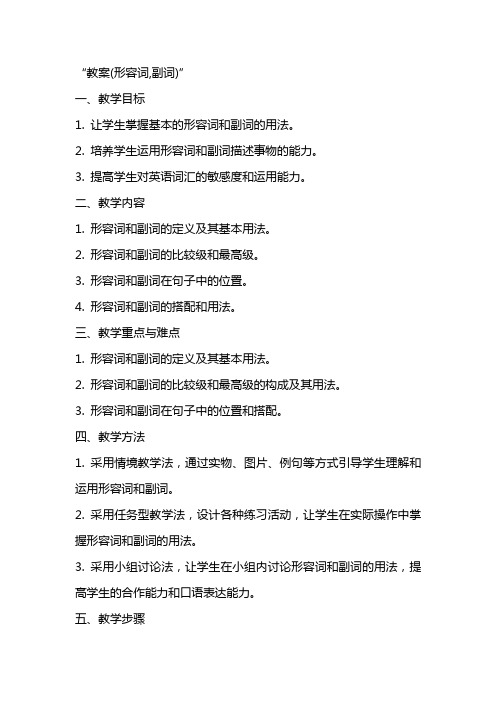
“教案(形容词,副词)”一、教学目标1. 让学生掌握基本的形容词和副词的用法。
2. 培养学生运用形容词和副词描述事物的能力。
3. 提高学生对英语词汇的敏感度和运用能力。
二、教学内容1. 形容词和副词的定义及其基本用法。
2. 形容词和副词的比较级和最高级。
3. 形容词和副词在句子中的位置。
4. 形容词和副词的搭配和用法。
三、教学重点与难点1. 形容词和副词的定义及其基本用法。
2. 形容词和副词的比较级和最高级的构成及其用法。
3. 形容词和副词在句子中的位置和搭配。
四、教学方法1. 采用情境教学法,通过实物、图片、例句等方式引导学生理解和运用形容词和副词。
2. 采用任务型教学法,设计各种练习活动,让学生在实际操作中掌握形容词和副词的用法。
3. 采用小组讨论法,让学生在小组内讨论形容词和副词的用法,提高学生的合作能力和口语表达能力。
五、教学步骤1. 引入:通过展示图片或实物,引导学生说出相应的形容词和副词,例如:美丽的花朵、快乐的小鸟。
2. 讲解:讲解形容词和副词的定义、用法及其比较级和最高级。
3. 练习:设计各种练习题,让学生巩固所学知识,如填空、选择、改写句子等。
4. 拓展:引导学生运用形容词和副词描述身边的人和事物,提高学生的实际运用能力。
5. 总结:对本节课的内容进行总结,强调形容词和副词的重要性和用法。
六、教学评估1. 课堂练习:观察学生在练习中的表现,了解他们对形容词和副词的理解和运用程度。
2. 小组讨论:评估学生在小组讨论中的参与程度和合作能力。
3. 课后作业:布置相关的课后作业,收集并批改,了解学生的掌握情况。
七、教学资源1. 实物、图片等教学辅助材料。
2. 英语教材和相关参考书籍。
3. 网络资源:例如英语学习网站、在线词典等。
八、教学进度安排1. 第一课时:介绍形容词和副词的定义及基本用法。
2. 第二课时:讲解形容词和副词的比较级和最高级。
3. 第三课时:讲解形容词和副词在句子中的位置和搭配。
教案(形容词,副词)
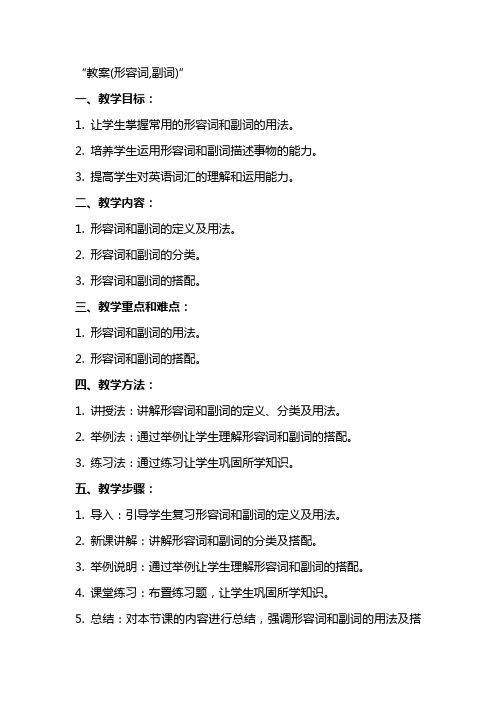
“教案(形容词,副词)”一、教学目标:1. 让学生掌握常用的形容词和副词的用法。
2. 培养学生运用形容词和副词描述事物的能力。
3. 提高学生对英语词汇的理解和运用能力。
二、教学内容:1. 形容词和副词的定义及用法。
2. 形容词和副词的分类。
3. 形容词和副词的搭配。
三、教学重点和难点:1. 形容词和副词的用法。
2. 形容词和副词的搭配。
四、教学方法:1. 讲授法:讲解形容词和副词的定义、分类及用法。
2. 举例法:通过举例让学生理解形容词和副词的搭配。
3. 练习法:通过练习让学生巩固所学知识。
五、教学步骤:1. 导入:引导学生复习形容词和副词的定义及用法。
2. 新课讲解:讲解形容词和副词的分类及搭配。
3. 举例说明:通过举例让学生理解形容词和副词的搭配。
4. 课堂练习:布置练习题,让学生巩固所学知识。
5. 总结:对本节课的内容进行总结,强调形容词和副词的用法及搭配。
6. 作业布置:布置课后作业,让学生进一步巩固所学知识。
六、教学评估:1. 课堂练习:观察学生在练习中的表现,了解他们对形容词和副词用法的掌握程度。
2. 课后作业:批改学生的课后作业,评估他们对课堂所学知识的巩固情况。
3. 小组讨论:组织学生进行小组讨论,鼓励他们运用所学知识描述事物,评估他们的实际运用能力。
七、教学拓展:1. 形容词和副词的比较级和最高级。
2. 形容词和副词在句子中的位置。
3. 形容词和副词与其他词类的搭配。
八、教学资源:1. 教材:选用适合学生的英语教材,如《新概念英语》、《牛津英语》等。
2. 课件:制作课件,辅助讲解形容词和副词的用法及搭配。
3. 练习题:准备一些练习题,用于巩固学生对形容词和副词的掌握。
九、教学反馈:1. 学生反馈:课后收集学生的反馈意见,了解他们对本节课教学内容的掌握程度。
2. 教师反思:教师根据学生的反馈和课堂表现,反思教学方法是否恰当,是否需要调整。
十、教学计划:1. 下一节课内容:讲解形容词和副词的比较级和最高级。
教案(形容词副词介词)
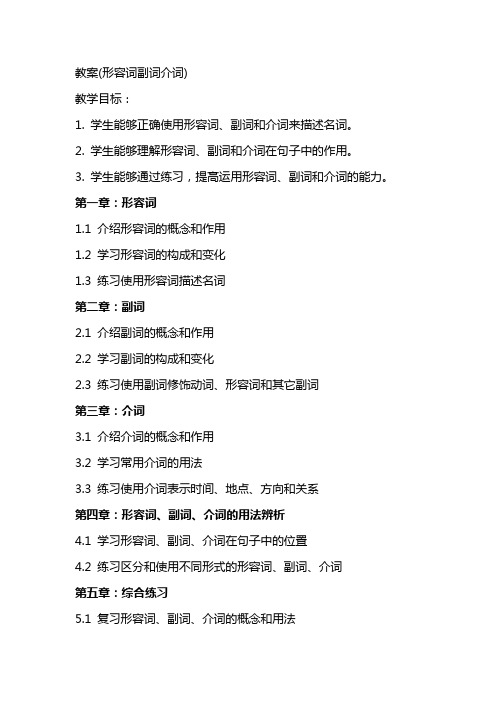
教案(形容词副词介词)教学目标:1. 学生能够正确使用形容词、副词和介词来描述名词。
2. 学生能够理解形容词、副词和介词在句子中的作用。
3. 学生能够通过练习,提高运用形容词、副词和介词的能力。
第一章:形容词1.1 介绍形容词的概念和作用1.2 学习形容词的构成和变化1.3 练习使用形容词描述名词第二章:副词2.1 介绍副词的概念和作用2.2 学习副词的构成和变化2.3 练习使用副词修饰动词、形容词和其它副词第三章:介词3.1 介绍介词的概念和作用3.2 学习常用介词的用法3.3 练习使用介词表示时间、地点、方向和关系第四章:形容词、副词、介词的用法辨析4.1 学习形容词、副词、介词在句子中的位置4.2 练习区分和使用不同形式的形容词、副词、介词第五章:综合练习5.1 复习形容词、副词、介词的概念和用法5.2 完成填空、选择和改写等练习题目5.3 学生之间进行互动交流,分享学习心得和经验教学方法:1. 采用讲解、示例、练习和互动交流等多种教学方法,帮助学生理解和掌握形容词、副词、介词的用法。
2. 通过实际例句和练习题目,让学生能够将所学知识应用到实际语境中。
3. 鼓励学生积极参与课堂活动,提高口语表达和写作能力。
评估方式:1. 课堂参与度和互动交流的表现。
2. 完成练习题目的准确性和速度。
3. 课后作业和作文的质量。
教学资源:1. 教学PPT和教案。
2. 练习题目和参考答案。
3. 参考教材和辅助资料。
第六章:形容词的比较级和最高级6.1 介绍形容词的比较级和最高级概念6.2 学习形容词的比较级和最高级的构成和变化6.3 练习使用形容词的比较级和最高级进行比较和描述第七章:副词的比较级和最高级7.1 介绍副词的比较级和最高级概念7.2 学习副词的比较级和最高级的构成和变化7.3 练习使用副词的比较级和最高级修饰动词、形容词和其它副词第八章:介词的搭配8.1 介绍介词的搭配概念和重要性8.2 学习常用介词的搭配用法8.3 练习使用介词搭配正确的形式表示时间、地点、方向和关系第九章:形容词、副词、介词在句子中的位置9.1 学习形容词、副词、介词在句子中的不同位置9.2 练习使用形容词、副词、介词修饰名词、动词和形容词9.3 分析句子结构,理解形容词、副词、介词的位置对句意的影响第十章:形容词、副词、介词的翻译技巧10.1 介绍形容词、副词、介词的翻译原则和技巧10.2 学习形容词、副词、介词在不同语境中的翻译方法10.3 练习翻译含有形容词、副词、介词的句子,提高翻译能力教学方法:1. 采用讲解、示例、练习和互动交流等多种教学方法,帮助学生理解和掌握形容词、副词、介词的用法。
教案(形容词副词介词)
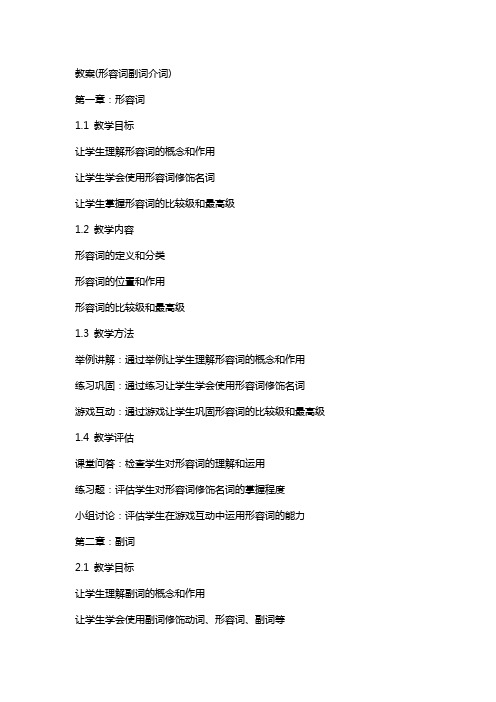
教案(形容词副词介词)第一章:形容词1.1 教学目标让学生理解形容词的概念和作用让学生学会使用形容词修饰名词让学生掌握形容词的比较级和最高级1.2 教学内容形容词的定义和分类形容词的位置和作用形容词的比较级和最高级1.3 教学方法举例讲解:通过举例让学生理解形容词的概念和作用练习巩固:通过练习让学生学会使用形容词修饰名词游戏互动:通过游戏让学生巩固形容词的比较级和最高级1.4 教学评估课堂问答:检查学生对形容词的理解和运用练习题:评估学生对形容词修饰名词的掌握程度小组讨论:评估学生在游戏互动中运用形容词的能力第二章:副词2.1 教学目标让学生理解副词的概念和作用让学生学会使用副词修饰动词、形容词、副词等让学生掌握副词的比较级和最高级2.2 教学内容副词的定义和分类副词的位置和作用副词的比较级和最高级2.3 教学方法举例讲解:通过举例让学生理解副词的概念和作用练习巩固:通过练习让学生学会使用副词修饰动词、形容词、副词等游戏互动:通过游戏让学生巩固副词的比较级和最高级2.4 教学评估课堂问答:检查学生对副词的理解和运用练习题:评估学生对副词修饰动词、形容词、副词等的掌握程度小组讨论:评估学生在游戏互动中运用副词的能力第三章:介词3.1 教学目标让学生理解介词的概念和作用让学生学会使用介词表示时间、地点、方向等让学生掌握介词的用法和搭配3.2 教学内容介词的定义和分类介词的用法和搭配介词的常见错误和注意事项3.3 教学方法举例讲解:通过举例让学生理解介词的概念和作用练习巩固:通过练习让学生学会使用介词表示时间、地点、方向等情景模拟:通过情景模拟让学生掌握介词的用法和搭配3.4 教学评估课堂问答:检查学生对介词的理解和运用练习题:评估学生对介词表示时间、地点、方向等的掌握程度角色扮演:评估学生在情景模拟中运用介词的能力第四章:形容词副词介词综合练习4.1 教学目标让学生综合运用形容词、副词、介词进行句子构建让学生学会在句子中正确使用形容词、副词、介词让学生提高语言表达能力和思维能力4.2 教学内容形容词、副词、介词的综合运用形容词、副词、介词在句子中的位置和作用形容词、副词、介词的搭配和用法4.3 教学方法举例讲解:通过举例让学生理解形容词、副词、介词的综合运用练习巩固:通过练习让学生学会在句子中正确使用形容词、副词、介词小组讨论:通过小组讨论让学生提高语言表达能力和思维能力4.4 教学评估课堂问答:检查学生对形容词、副词、介词综合运用的理解练习题:评估学生正确使用形容词、副词、介词的能力小组展示:评估学生在小组讨论中运用形容词、副词、介词的综合能力第五章:形容词、副词、介词在语境中的应用5.1 教学目标让学生理解形容词、副词、介词在具体语境中的作用让学生学会在不同的语境中正确使用形容词、副词、介词让学生提高语言表达能力和思维能力5.2 教学内容形容词、副词、介词在语境中的运用不同语境对形容词、副词、介词选择的影响形容词、副词、介词在语境中的搭配和用法5.3 教学方法举例讲解:通过举例让学生理解形容词、副词、介词在语境中的作用情景模拟:通过情景模拟让学生学会在不同的语境中正确使用形容词、副词、介词小组讨论:通过小组讨论让学生提高语言表达能力和思维能力5.4 教学评估课堂问答:检查学生对形容词、副词、介词在语境中运用的理解情景剧:评估学生在情景模拟中使用形容词、副词、介词的能力小组评价:评估学生在小组讨论中运用形容词、副词、介词的语境应用能力第六章:形容词、副词、介词的语法功能6.1 教学目标让学生理解形容词、副词、介词的语法功能让学生学会在句子中正确使用形容词、副词、介词让学生掌握形容词、副词、介词的句子结构6.2 教学内容形容词、副词、介词的语法功能形容词、副词、介词在句子中的位置形容词、副词、介词的句子结构分析6.3 教学方法举例讲解:通过举例让学生理解形容词、副词、介词的语法功能句子构建:通过练习让学生学会在句子中正确使用形容词、副词、介词案例分析:通过案例分析让学生掌握形容词、副词、介词的句子结构6.4 教学评估课堂问答:检查学生对形容词、副词、介词语法功能的了解句子练习:评估学生在句子构建中使用形容词、副词、介词的准确性语法测试:评估学生掌握形容词、副词、介词句子结构的能力第七章:形容词、副词、介词的跨文化应用7.1 教学目标让学生了解形容词、副词、介词在不同文化背景中的差异让学生学会在跨文化语境中正确使用形容词、副词、介词让学生提高跨文化交际能力和语言运用能力7.2 教学内容形容词、副词、介词的跨文化差异不同文化背景下形容词、副词、介词的用法和搭配形容词、副词、介词在跨文化交际中的注意事项7.3 教学方法举例讲解:通过举例让学生了解形容词、副词、介词的跨文化差异文化对比:通过文化对比让学生学会在跨文化语境中正确使用形容词、副词、介词角色扮演:通过角色扮演让学生提高跨文化交际能力和语言运用能力7.4 教学评估课堂问答:检查学生对形容词、副词、介词跨文化应用的理解文化情境题:评估学生在跨文化语境中使用形容词、副词、介词的能力角色扮演评价:评估学生在角色扮演中运用形容词、副词、介词的跨文化交际能力第八章:形容词、副词、介词在日常写作中的应用8.1 教学目标让学生掌握形容词、副词、介词在日常写作中的用法让学生学会运用形容词、副词、介词提高写作质量让学生提高写作能力和表达能力8.2 教学内容形容词、副词、介词在日常写作中的作用形容词、副词、介词在写作中的搭配和用法形容词、副词、介词在写作中的实践指导8.3 教学方法举例讲解:通过举例让学生了解形容词、副词、介词在日常写作中的用法写作练习:通过写作练习让学生学会运用形容词、副词、介词提高写作质量作文互评:通过作文互评让学生提高写作能力和表达能力8.4重点解析本文教案主要围绕形容词、副词、介词的概念、用法、搭配以及在语境中的应用展开教学。
教案(形容词,副词)
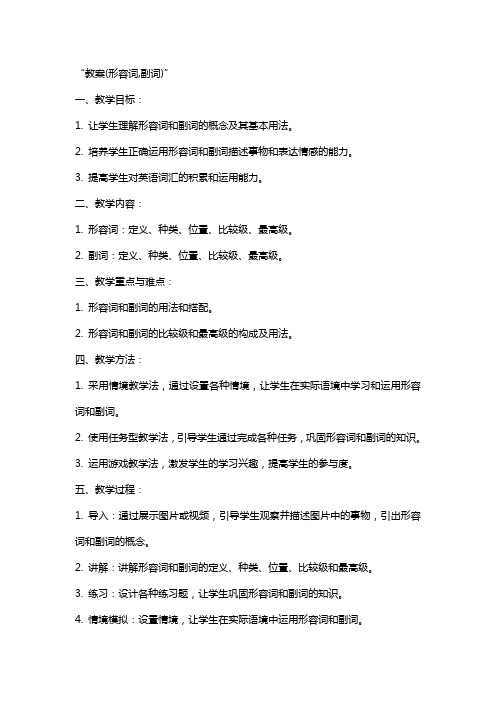
“教案(形容词,副词)”一、教学目标:1. 让学生理解形容词和副词的概念及其基本用法。
2. 培养学生正确运用形容词和副词描述事物和表达情感的能力。
3. 提高学生对英语词汇的积累和运用能力。
二、教学内容:1. 形容词:定义、种类、位置、比较级、最高级。
2. 副词:定义、种类、位置、比较级、最高级。
三、教学重点与难点:1. 形容词和副词的用法和搭配。
2. 形容词和副词的比较级和最高级的构成及用法。
四、教学方法:1. 采用情境教学法,通过设置各种情境,让学生在实际语境中学习和运用形容词和副词。
2. 使用任务型教学法,引导学生通过完成各种任务,巩固形容词和副词的知识。
3. 运用游戏教学法,激发学生的学习兴趣,提高学生的参与度。
五、教学过程:1. 导入:通过展示图片或视频,引导学生观察并描述图片中的事物,引出形容词和副词的概念。
2. 讲解:讲解形容词和副词的定义、种类、位置、比较级和最高级。
3. 练习:设计各种练习题,让学生巩固形容词和副词的知识。
4. 情境模拟:设置情境,让学生在实际语境中运用形容词和副词。
5. 任务完成:布置任务,让学生分组讨论并完成,以此巩固形容词和副词的用法。
6. 游戏互动:设计形容词和副词相关的游戏,让学生在游戏中学习和巩固知识。
7. 总结:对本节课的内容进行总结,强调形容词和副词的重要性和用法。
8. 作业布置:布置相关作业,让学生课后巩固所学知识。
六、教学评价:1. 通过课堂表现、练习完成情况和任务成果,评价学生对形容词和副词的理解和运用能力。
2. 结合课后作业,检查学生对形容词和副词知识的掌握程度。
3. 鼓励学生自我评价和同伴评价,提高学生的自我意识和合作意识。
七、教学拓展:1. 引导学生阅读含有丰富形容词和副词的文章,提高学生的阅读理解能力。
2. 组织学生进行写作训练,要求运用形容词和副词描述人物、场景和故事。
3. 开展形容词和副词的创意写作活动,激发学生的创意思维。
八、教学资源:1. 图片、视频、音频等多媒体资源。
形容词副词教案
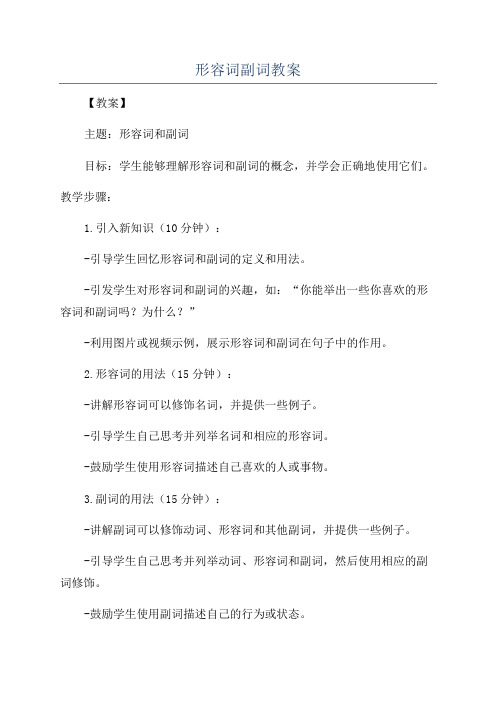
形容词副词教案【教案】主题:形容词和副词目标:学生能够理解形容词和副词的概念,并学会正确地使用它们。
教学步骤:1.引入新知识(10分钟):-引导学生回忆形容词和副词的定义和用法。
-引发学生对形容词和副词的兴趣,如:“你能举出一些你喜欢的形容词和副词吗?为什么?”-利用图片或视频示例,展示形容词和副词在句子中的作用。
2.形容词的用法(15分钟):-讲解形容词可以修饰名词,并提供一些例子。
-引导学生自己思考并列举名词和相应的形容词。
-鼓励学生使用形容词描述自己喜欢的人或事物。
3.副词的用法(15分钟):-讲解副词可以修饰动词、形容词和其他副词,并提供一些例子。
-引导学生自己思考并列举动词、形容词和副词,然后使用相应的副词修饰。
-鼓励学生使用副词描述自己的行为或状态。
4.练习(15分钟):-分发练习题,要求学生根据要求用适当的形容词或副词填空。
-鼓励学生相互检查答案并讨论解题思路。
5.总结(5分钟):-总结形容词和副词的定义和用法。
-鼓励学生在日常生活中注意形容词和副词的使用,并多加练习。
教学资源:-图片或视频展示形容词和副词的例子。
-练习题和答案。
评估:-教师观察学生在课堂上的参与程度和答题情况。
-练习题的完成情况和正确率。
拓展活动:1.让学生通过观察周围环境,列举更多的形容词和副词,并分析其在句子中的作用。
2.给学生定一个主题,让他们编写一个小故事,并在故事中运用形容词和副词。
然后请他们将故事朗读给同学们听,让同学们猜测故事中的形容词和副词。
3.鼓励学生根据自己的喜好和想象,设计一款形容词和副词的卡片游戏。
并用游戏的方式让同学们学习和使用形容词和副词。
小学教案学习形容词和副词的用法

小学教案学习形容词和副词的用法学习形容词和副词的用法教学内容:形容词和副词的定义及用法教学目标:通过学习形容词和副词的用法,使学生能够正确运用形容词和副词来描述人、事、物的属性和行为方式。
教学重点:掌握形容词和副词的基本用法和差异。
教学难点:正确区分形容词和副词的用法。
教学准备:单词卡片、多媒体课件教学过程:一、导入(5分钟)1. 老师可以利用图片或实物向学生展示不同的物品,让学生描述这些物品的特征,并引导学生思考用什么词可以最准确地描述。
2. 引导学生回想上一节所学的形容词,以复习学生已有的知识。
二、点拨讲解(15分钟)1. 讲解形容词的定义:形容词是用来形容、修饰名词的词语,它可以描述人、事、物的性质、状态或特征。
2. 列示形容词的常见用法,并通过例句让学生理解其用法。
3. 讲解副词的定义:副词是修饰动词、形容词、其他副词或整个句子的词语,它可以描述人们做事的方式、时间、程度等。
4. 列示副词的常见用法,并通过例句让学生理解其用法。
三、练习活动(20分钟)1. 分发单词卡片,让学生根据教师布置的任务,选择合适的形容词或副词来描述卡片上的图片或事物。
2. 设计一些情景,让学生在小组内进行对话,使用形容词和副词对话进行描写和回答问题。
3. 利用多媒体课件完成形容词和副词的选择题练习,帮助学生进一步巩固所学内容。
四、合作探究(15分钟)1. 将学生分成小组,让每个小组根据教师提供的主题,设计一个小故事,要求其中包含尽可能多的形容词和副词。
2. 鼓励学生交流和合作,互相提出建议和修改,展示最后的成果。
五、拓展延伸(10分钟)1. 老师可以播放一段短视频或音频,让学生仔细观听后,找出其中使用的形容词和副词,并解释其用法和作用。
2. 鼓励学生在日常生活中积极观察和运用形容词和副词,提高对语言的感知和运用能力。
六、总结归纳(5分钟)1. 整理学生活动中遇到的困惑和问题,对学生的回答进行点评和总结。
2. 让学生通过口头或书面方式总结形容词和副词的用法,并归纳出形容词修饰名词,副词修饰动词、形容词和其他副词的基本规律。
形容词,副词复习教案
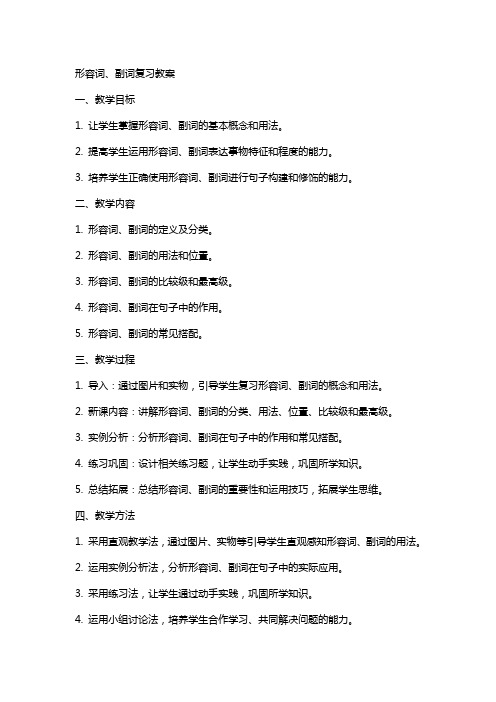
形容词、副词复习教案一、教学目标1. 让学生掌握形容词、副词的基本概念和用法。
2. 提高学生运用形容词、副词表达事物特征和程度的能力。
3. 培养学生正确使用形容词、副词进行句子构建和修饰的能力。
二、教学内容1. 形容词、副词的定义及分类。
2. 形容词、副词的用法和位置。
3. 形容词、副词的比较级和最高级。
4. 形容词、副词在句子中的作用。
5. 形容词、副词的常见搭配。
三、教学过程1. 导入:通过图片和实物,引导学生复习形容词、副词的概念和用法。
2. 新课内容:讲解形容词、副词的分类、用法、位置、比较级和最高级。
3. 实例分析:分析形容词、副词在句子中的作用和常见搭配。
4. 练习巩固:设计相关练习题,让学生动手实践,巩固所学知识。
5. 总结拓展:总结形容词、副词的重要性和运用技巧,拓展学生思维。
四、教学方法1. 采用直观教学法,通过图片、实物等引导学生直观感知形容词、副词的用法。
2. 运用实例分析法,分析形容词、副词在句子中的实际应用。
3. 采用练习法,让学生通过动手实践,巩固所学知识。
4. 运用小组讨论法,培养学生合作学习、共同解决问题的能力。
五、教学评价1. 课堂参与度:观察学生在课堂上的参与程度,了解学生对知识的掌握情况。
2. 练习完成情况:检查学生练习题的完成情况,评估学生的学习效果。
3. 小组讨论:评价学生在小组讨论中的表现,考察学生的合作能力和思维拓展程度。
4. 课后作业:布置相关作业,要求学生在课后巩固所学知识,提高运用能力。
六、教学资源1. 图片和实物:用于直观展示形容词、副词的描述对象。
2. 练习题:设计不同难度的练习题,巩固所学知识。
3. 小组讨论材料:提供相关话题,促进学生互动交流。
4. 教学课件:制作课件,辅助讲解和展示知识点。
5. 课后作业:布置相关作业,让学生巩固所学知识。
七、教学步骤1. 导入:通过图片和实物,引导学生复习形容词、副词的概念和用法。
2. 新课内容:讲解形容词、副词的分类、用法、位置、比较级和最高级。
教案(形容词副词)

教案(形容词副词)一、教学目标1. 让学生理解形容词和副词的概念及其基本用法。
2. 培养学生正确运用形容词和副词描述事物和表达情感的能力。
3. 提高学生英语听说读写技能,增强语感。
二、教学内容1. 形容词:描述事物的特征、性质、状态等。
2. 副词:修饰动词、形容词、其他副词或整个句子,表示时间、地点、程度、方式等。
三、教学方法1. 情景教学法:通过设定各种生活场景,让学生在实际语境中学习和运用形容词和副词。
2. 互动教学法:引导学生进行小组讨论、pr work 等活动,提高学生的参与度和积极性。
3. 任务型教学法:设计各种任务,让学生在完成任务的过程中运用所学知识。
四、教学步骤1. 引入:通过展示图片或视频,引导学生关注事物的特征,激发学习兴趣。
2. 讲解:讲解形容词和副词的定义、用法和分类,让学生掌握基本知识。
3. 练习:设计各种练习题,让学生巩固所学知识,提高运用能力。
4. 互动:组织小组讨论或pr work,让学生在实际语境中运用形容词和副词。
5. 任务:设计任务,让学生在完成任务的过程中运用所学知识。
6. 总结:对本节课的内容进行总结,强调重点和难点。
五、课后作业1. 复习本节课所学的形容词和副词,总结它们的用法和搭配。
2. 运用所学知识,编写一段描述某个物品或人物的短文。
3. 完成课后练习题,检测自己的学习效果。
六、教学评价1. 课堂参与度:观察学生在课堂活动中的参与程度,了解他们对形容词和副词的理解和运用情况。
2. 练习完成情况:检查学生完成的练习题,评估他们对形容词和副词用法的掌握程度。
3. 小组讨论和pr work:评价学生在小组讨论和pr work中的表现,了解他们在实际语境中运用形容词和副词的能力。
4. 课后作业:检查学生的课后作业,评估他们对课堂所学知识的巩固程度。
七、教学拓展1. 形容词和副词的转换:教授形容词和副词的转换规则,如形容词转副词的方法。
2. 形容词和副词的级:介绍形容词和副词的比较级和最高级,让学生了解其用法和构成。
形容词,副词复习教案
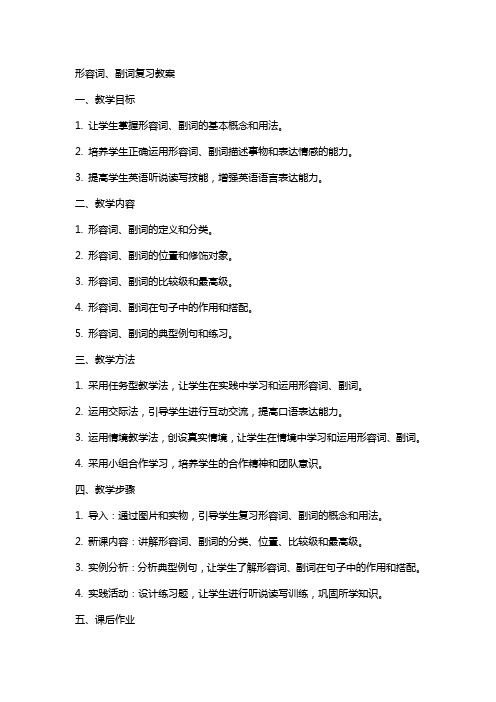
形容词、副词复习教案一、教学目标1. 让学生掌握形容词、副词的基本概念和用法。
2. 培养学生正确运用形容词、副词描述事物和表达情感的能力。
3. 提高学生英语听说读写技能,增强英语语言表达能力。
二、教学内容1. 形容词、副词的定义和分类。
2. 形容词、副词的位置和修饰对象。
3. 形容词、副词的比较级和最高级。
4. 形容词、副词在句子中的作用和搭配。
5. 形容词、副词的典型例句和练习。
三、教学方法1. 采用任务型教学法,让学生在实践中学习和运用形容词、副词。
2. 运用交际法,引导学生进行互动交流,提高口语表达能力。
3. 运用情境教学法,创设真实情境,让学生在情境中学习和运用形容词、副词。
4. 采用小组合作学习,培养学生的合作精神和团队意识。
四、教学步骤1. 导入:通过图片和实物,引导学生复习形容词、副词的概念和用法。
2. 新课内容:讲解形容词、副词的分类、位置、比较级和最高级。
3. 实例分析:分析典型例句,让学生了解形容词、副词在句子中的作用和搭配。
4. 实践活动:设计练习题,让学生进行听说读写训练,巩固所学知识。
五、课后作业1. 完成练习题,加强巩固。
2. 搜集生活中的形容词、副词实例,进行观察和分析。
3. 结合所学知识,尝试编写含有形容词、副词的句子或小短文。
4. 准备下一节课的展示活动。
六、教学评估1. 课堂互动:观察学生在课堂上的参与程度、发言情况和合作表现,评估学生对形容词、副词的理解和运用能力。
2. 练习题完成情况:检查学生课后练习的完成质量,评估学生对知识的掌握程度。
3. 课后作业:评估学生对课堂所学知识的应用能力和创新思维。
4. 学生自评、互评:鼓励学生自我反思,互相学习,提高表达能力。
七、教学拓展1. 形容词、副词在诗歌、文学作品中的运用:引导学生欣赏文学作品,体会形容词、副词在描绘形象、表达情感方面的作用。
2. 形容词、副词游戏:设计有趣的游戏,让学生在游戏中巩固所学知识,提高语言运用能力。
形容词和副词教案

形容词和副词教案第一章:形容词和副词的概念与分类1.1 形容词的概念定义:形容词是用来修饰名词或代名词的词,表示事物的性质、状态、特征等。
举例:美丽、聪明、高大、快乐1.2 副词的概念定义:副词是用来修饰动词、形容词、其他副词或整个句子的词,表示程度、时间、地点等。
举例:很、非常、逐渐、到处1.3 形容词和副词的分类形容词分类:颜色形容词(红色、蓝色)、大小形容词(大型、小型)、形状形容词(圆形、方形)等。
副词分类:程度副词(很、非常)、时间副词(立即、逐渐)、地点副词(到处、在家)等。
第二章:形容词和副词的用法2.1 形容词的用法修饰名词:美丽的花园、高大的建筑在名词后的定语从句中作形容词:The book you gave me is very interesting. 用“tooto”结构表示过度:The cake is too sweet to eat.2.2 副词的用法修饰动词、形容词或其他副词:她跑得很快、非常高兴、逐渐消失在动词或形容词后的状语从句中作副词:If it rns, we will cancel the trip.用“enough to”结构表示足够:He is strong enough to lift the heavy box. 第三章:形容词和副词的比较级和最高级3.1 形容词的比较级和最高级比较级:表示两个事物之间的比较,如:taller、happier3.2 副词的比较级和最高级比较级:表示两个事物之间的比较,如:faster、louder3.3 形容词和副词比较级、最高级的构成规则变化:在词尾加上-er变为比较级,加上-est变为最高级,如:big-bigger-biggest不规则变化:一些单词的比较级和最高级形式不同,如:good-better-best、bad-worse-worst第四章:形容词和副词的练习4.1 形容词练习写出下列名词的形容词形式:太阳、鞋子、城市、学校选出正确的形容词填空:This is a _____ car. (美丽、漂亮)4.2 副词练习写出下列动词的副词形式:跑、学习、吃饭、睡觉选出正确的副词填空:She speaks English _____. (流利、熟练)第五章:形容词和副词在句子中的应用5.1 形容词在句子中的应用描述事物的性质、状态:The sky is blue.提问:What color is your car?5.2 副词在句子中的应用修饰动词、形容词或其他副词:He runs quickly.提问:How do you spell your name?形容词和副词教案第六章:形容词和副词的的位置6.1 形容词的位置放在名词之前:美丽的花园放在名词之后的定语从句中:The book you gave me is very interesting. 6.2 副词的位置修饰动词、形容词或其他副词:她跑得很快放在动词或形容词后的状语从句中:If it rns, we will cancel the trip.第七章:形容词和副词的短语搭配7.1 形容词的短语搭配形容词+and+形容词:美丽的花园和热闹的市集形容词+enough+to+动词:She is strong enough to lift the heavy box. 7.2 副词的短语搭配副词+副词:quickly and carefully副词+动词:runs quickly第八章:形容词和副词的错误分析8.1 形容词的常见错误误用名词作形容词:She has a beautiful dress.(错误:dress应为gift)忘掉定冠词the:The girl with a red hat is my sister.(错误:with前应有the)8.2 副词的常见错误误用介词作副词:He speaks English very good.(错误:good应为well)忘掉介词at:She looked at the picture for a long time.(错误:for前应有at)第九章:形容词和副词的练习(continued)9.1 形容词练习(continued)选出正确的形容词填空:This is a _____ car.(美丽、漂亮的)完成句子:The _____ cat is sleeping on the sofa.(大的、小的)9.2 副词练习(continued)选出正确的副词填空:She speaks English _____.(流利、熟练的)完成句子:He _____ finished his homework and went out to play.(很快、慢慢地)第十章:形容词和副词在句子中的应用(continued)10.1 形容词在句子中的应用(continued)描述事物的性质、状态:The sky is blue.提问:What color is your car?10.2 副词在句子中的应用(continued)修饰动词、形容词或其他副词:He runs quickly.提问:How do you spell your name?形容词和副词教案第十一章:形容词和副词的比较结构11.1 形容词的比较结构比较级:表示两个事物之间的比较,如:taller、happier11.2 副词的比较结构比较级:表示两个事物之间的比较,如:faster、louder第十二章:形容词和副词的交替使用12.1 形容词和副词的交替使用形容词+副词:She is very careful.副词+形容词:She runs very fast.12.2 形容词和副词的交替使用练习选出正确的形式填空:The cake is _____ sweet _____ I can eat.(太、非常)完成句子:He is _____ tall _____ his brother.(比、还要)第十三章:形容词和副词的否定形式13.1 形容词的否定形式not+形容词:The sky is not blue.tooto:The cake is too sweet to eat.13.2 副词的否定形式not+副词:She does not speak English well.tooto:She is too tired to go out.第十四章:形容词和副词的综合练习14.1 形容词和副词的综合练习选择正确的形容词或副词填空:The cat is _____ (small/smaller) than the dog. 根据句子完成填空:He _____ (run/runs) quickly to the school.14.2 形容词和副词的句子构建构建比较级句子:My younger brother is _____ (tall) than me.构建最高级句子:The _____ (tall) building in our city is the library.第十五章:形容词和副词的教学活动15.1 形容词和副词的教学活动形容词抢答游戏:学生抢答给出名词的形容词形式。
形容词和副词教案
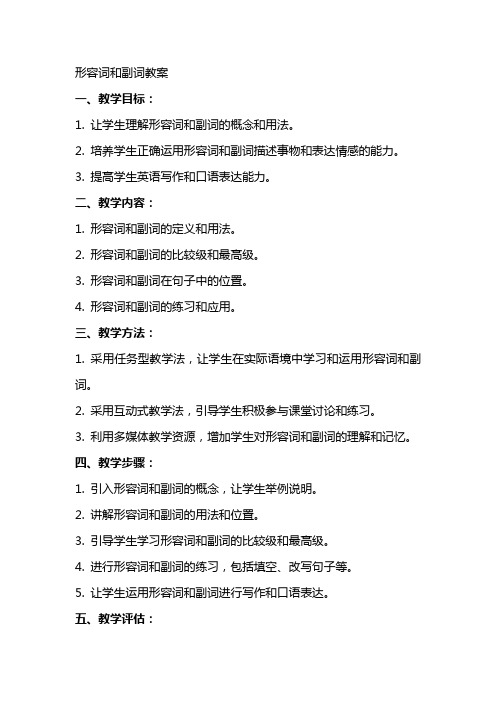
形容词和副词教案一、教学目标:1. 让学生理解形容词和副词的概念和用法。
2. 培养学生正确运用形容词和副词描述事物和表达情感的能力。
3. 提高学生英语写作和口语表达能力。
二、教学内容:1. 形容词和副词的定义和用法。
2. 形容词和副词的比较级和最高级。
3. 形容词和副词在句子中的位置。
4. 形容词和副词的练习和应用。
三、教学方法:1. 采用任务型教学法,让学生在实际语境中学习和运用形容词和副词。
2. 采用互动式教学法,引导学生积极参与课堂讨论和练习。
3. 利用多媒体教学资源,增加学生对形容词和副词的理解和记忆。
四、教学步骤:1. 引入形容词和副词的概念,让学生举例说明。
2. 讲解形容词和副词的用法和位置。
3. 引导学生学习形容词和副词的比较级和最高级。
4. 进行形容词和副词的练习,包括填空、改写句子等。
5. 让学生运用形容词和副词进行写作和口语表达。
五、教学评估:1. 课堂参与度:观察学生在课堂上的积极参与程度和表现。
2. 练习完成情况:检查学生完成练习的情况和答案的正确性。
3. 写作和口语表达:评估学生在写作和口语表达中使用形容词和副词的情况和准确性。
六、教学资源:1. 形容词和副词的PPT演示文稿。
2. 形容词和副词的练习题和答案。
3. 形容词和副词的例句和情景剧。
4. 写作和口语表达的素材和指导。
七、教学重点和难点:1. 形容词和副词的概念和用法。
2. 形容词和副词的比较级和最高级的构成和用法。
3. 形容词和副词在句子中的位置和搭配。
4. 正确运用形容词和副词进行写作和口语表达。
八、教学计划:1. 第一课时:介绍形容词和副词的概念和用法。
2. 第二课时:讲解形容词和副词的比较级和最高级。
3. 第三课时:练习形容词和副词的运用。
4. 第四课时:写作和口语表达练习。
5. 第五课时:总结和复习形容词和副词的知识点。
九、教学评价:1. 课堂表现:观察学生在课堂上的参与程度、提问回答和小组合作等情况。
教案(形容词,副词)
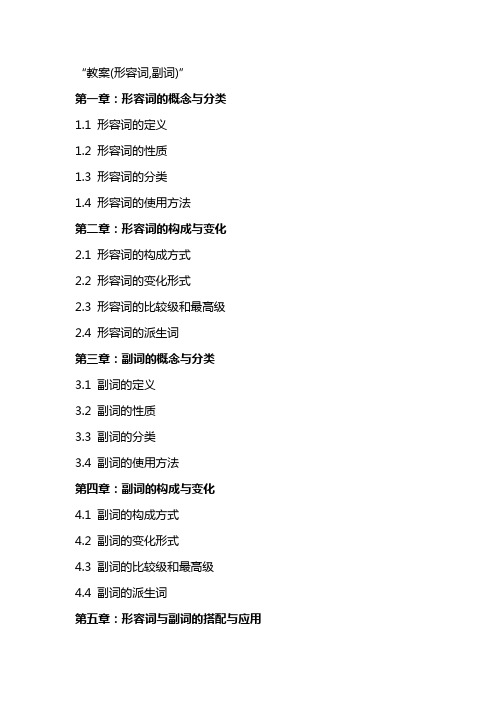
“教案(形容词,副词)”第一章:形容词的概念与分类1.1 形容词的定义1.2 形容词的性质1.3 形容词的分类1.4 形容词的使用方法第二章:形容词的构成与变化2.1 形容词的构成方式2.2 形容词的变化形式2.3 形容词的比较级和最高级2.4 形容词的派生词第三章:副词的概念与分类3.1 副词的定义3.2 副词的性质3.3 副词的分类3.4 副词的使用方法第四章:副词的构成与变化4.1 副词的构成方式4.2 副词的变化形式4.3 副词的比较级和最高级4.4 副词的派生词第五章:形容词与副词的搭配与应用5.1 形容词与副词的搭配原则5.2 形容词与副词的搭配实例5.3 形容词与副词在句子中的位置5.4 形容词与副词的应用技巧第六章:形容词和副词在句子中的功能6.1 形容词在句子中的功能6.2 副词在句子中的功能6.3 形容词和副词的修饰对象6.4 形容词和副词的句法位置第七章:形容词和副词的比较级与最高级7.1 形容词的比较级与最高级构成7.2 副词的比较级与最高级构成7.3 形容词和副词比较级与最高级的用法7.4 形容词和副词比较级与最高级的例句第八章:形容词和副词的否定形式8.1 形容词的否定形式8.2 副词的否定形式8.3 形容词和副词否定形式的用法8.4 形容词和副词否定形式的例句第九章:形容词和副词的短语搭配9.1 形容词的短语搭配9.2 副词的短语搭配9.3 形容词和副词短语搭配的用法9.4 形容词和副词短语搭配的例句第十章:形容词和副词的语义韵10.1 形容词的语义韵10.2 副词的语义韵10.3 形容词和副词语义韵的用法10.4 形容词和副词语义韵的例句第十一章:形容词和副词的跨文化使用11.1 形容词和副词在不同文化中的差异11.2 形容词和副词的cultural nuances 11.3 形容词和副词在特定语言中的特殊用法11.4 形容词和副词的跨文化交际应用第十二章:形容词和副词在学术写作中的运用12.1 形容词和副词在学术写作中的重要性12.2 形容词和副词在论文写作中的应用12.3 形容词和副词的准确性和精确度12.4 形容词和副词在学术写作中的常见错误第十三章:形容词和副词在创意写作中的作用13.1 形容词和副词在创意写作中的创造性使用13.2 形容词和副词在构建小说世界中的作用13.3 形容词和副词在诗歌中的韵律和节奏13.4 形容词和副词在创意写作中的练习和技巧第十四章:形容词和副词在科技和商务写作中的应用14.1 形容词和副词在科技写作中的清晰性14.2 形容词和副词在商务写作中的专业性14.3 形容词和副词在报告和提案中的使用14.4 形容词和副词在科技和商务写作中的实例分析第十五章:形容词和副词的评估与练习15.1 形容词和副词的自我评估工具15.2 形容词和副词的在线练习和游戏15.3 形容词和副词的写作练习15.4 形容词和副词的口语练习和口语角活动重点和难点解析本文主要介绍了形容词和副词的基本概念、分类、构成、变化、搭配和应用等方面的内容。
教案3--形容词副词
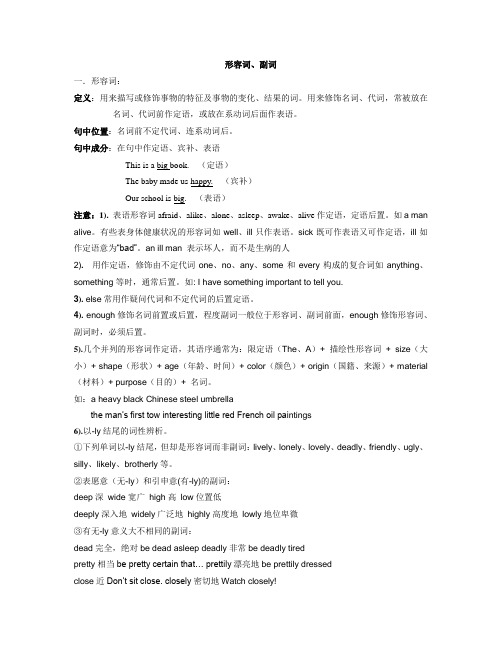
形容词、副词一.形容词:定义:用来描写或修饰事物的特征及事物的变化、结果的词。
用来修饰名词、代词,常被放在名词、代词前作定语,或放在系动词后面作表语。
句中位置:名词前不定代词、连系动词后。
句中成分:在句中作定语、宾补、表语This is a big book.(定语)The baby made us happy.(宾补)Our school is big.(表语)注意:1). 表语形容词afraid、alike、alone、asleep、awake、alive作定语,定语后置。
如a man alive。
有些表身体健康状况的形容词如well、ill只作表语。
sick既可作表语又可作定语,ill如作定语意为“bad”。
an ill man 表示坏人,而不是生病的人2). 用作定语,修饰由不定代词one、no、any、some和every构成的复合词如anything、something等时,通常后置。
如: I have something important to tell you.3). else常用作疑问代词和不定代词的后置定语。
4). enough修饰名词前置或后置,程度副词一般位于形容词、副词前面,enough修饰形容词、副词时,必须后置。
5).几个并列的形容词作定语,其语序通常为:限定语(The、A)+ 描绘性形容词+ size(大小)+ shape(形状)+ age(年龄、时间)+ color(颜色)+ origin(国籍、来源)+ material (材料)+ purpose(目的)+ 名词。
如:a heavy black Chinese steel umbrellath e man’s first tow interesting little red French oil pai ntings6).以-ly结尾的词性辨析。
①下列单词以-ly结尾,但却是形容词而非副词:lively、lonely、lovely、deadly、friendly、ugly、silly、likely、brotherly等。
- 1、下载文档前请自行甄别文档内容的完整性,平台不提供额外的编辑、内容补充、找答案等附加服务。
- 2、"仅部分预览"的文档,不可在线预览部分如存在完整性等问题,可反馈申请退款(可完整预览的文档不适用该条件!)。
- 3、如文档侵犯您的权益,请联系客服反馈,我们会尽快为您处理(人工客服工作时间:9:00-18:30)。
形容词、副词
一.形容词:
定义:用来描写或修饰事物的特征及事物的变化、结果的词。
用来修饰名词、代词,常被放在名词、代词前作定语,或放在系动词后面作表语。
句中位置:名词前不定代词、连系动词后。
句中成分:在句中作定语、宾补、表语
This is a big book. (定语)
The baby made us happy. (宾补)
Our school is big. (表语)
注意:1). 表语形容词afraid、alike、alone、asleep、awake、alive作定语,定语后置。
如a man alive。
有些表身体健康状况的形容词如well、ill只作表语。
sick既可作表语又可作定语,ill如作定语意为“bad”。
an ill man 表示坏人,而不是生病的人
2). 用作定语,修饰由不定代词one、no、any、some和every构成的复合词如anything、something等时,通常后置。
如: I have something important to tell you.
3). else常用作疑问代词和不定代词的后置定语。
4). enough修饰名词前置或后置,程度副词一般位于形容词、副词前面,enough修饰形容词、副词时,必须后置。
5).几个并列的形容词作定语,其语序通常为:限定语(The、A)+ 描绘性形容词 + size(大小)+ shape(形状)+ age(年龄、时间)+ color(颜色)+ origin(国籍、来源)+ material (材料)+ purpose(目的)+ 名词。
如:a heavy black Chinese steel umbrella
the man’s first tow interesting little red French oil pai ntings
6).以-ly结尾的词性辨析。
①下列单词以-ly结尾,但却是形容词而非副词:lively、lonely、lovely、deadly、friendly、ugly、silly、likely、brotherly等。
②表愿意(无-ly)和引申意(有-ly)的副词:
deep深 wide宽广 high高 low位置低
deeply深入地 widely广泛地 highly高度地 lowly地位卑微
③有无-ly意义大不相同的副词:
dead完全,绝对be dead asleep deadly非常be deadly tired
pretty相当be pretty certain that… prettily漂亮地be prettily dressed
close近Don’t sit close. closely密切地Watch closely!
late晚、迟arrive late, come late lately最近I haven’t seen him lately(recently).
形容词的比较级与最高级
1.单音节词直接在后加-er/-est, 如:tall—taller—tallest
2.以字母e 为结尾的单音节词,只加-r/-st. 如:large—larger—largest
3.以重读闭音节为结尾的词,如果词尾只有一个辅音字母,应先双写这个辅音字母,再加-er/-est,(辅元辅)如:thin—thinner—thinnest big—bigger—biggest
4.以y为结尾的词,先把y改成i再加-er/-est, 如happy—happier—happiest
5.多数双音节词和多音节词,在前面加more/most
如:beautiful—more beautiful—the most beautiful
6.不规则变化:好坏多少元(远)老
good/well—better—best; bad/ill —worse—worst; many/much—more—most
little —less—least; far—farther/further —farthest/furthest
old —older/elder—oldest/eldest
注意:te 的比较级,最高级也有两种变法。
Later, latest和 latter,last.前者是指时
间上的先后,后者是指顺序上的
先后。
2.Elder与older 区别是,前者是在家庭中兄弟姐妹的长幼,后范围更广。
3.Farther与further区别是,前者强调具体距离上远,后者是指抽象意义上的更进一步。
二.副词
定义:表示事物变化特征以及事物变化结果特征的词.用来修饰动词、形容词及其他副词。
句中位置:放在动词前,情态动词、助动词、be动词后。
句中成分:修饰动词、形容词及其他副词,在句中作状语。
The old man walks slowly on the street. (修饰动词)
She was deeply moved by the movie. (修饰形容词)
He studies very hard. (修饰副词)
副词的比较级与最高级
1.单音节词直接在后加-er/-est, 如:fast—faster—fastest
2.多数双音节词和多音节词,在前面加more/most
如:quickly—more quickly—most quickly
3.不规则变化:well—better—best
三.形容词与副词原级的用法
构成:形容词、副词的原级即本身。
用法:
1.“as + …+ as”的结构,表示双方在程度、性质、特征等某方面相等;
如:He is as tall as a small tree.
2.“not so(as) + …+ as”的结构,表示双方不相等,一方不如另一方;
如:Our room is not so/as big as yours.
3.“倍数 + as + …+ as”的结构,表示一方是另一方的若干倍。
如:
如:his building looks not so (as)high as that one.
四.形容词与副词比较级的用法
1.对方比较,表示一方超过另一方时,用“比较级+ than”的结构表示。
如:This picture is more beautiful than that one.
2.表示一方不及另一方时,用“less + 原级+ than”的结构表示。
如: This room is less beautiful than that one.
3.表示一方超过另一方的程度或数量时,可在比较级前加表示程度的状语,如e ven、a lot、a bit、a little、still、much、far、yet、by far等修饰。
如:He works even harder than before.
4.比较级+and +比较级,表示“越来越怎么样”
如:The weather gets hotter and hotter
5.the +,比较级,the+比较级。
表示“越…,就越…”
如:The harder you work at it, the better you will do in it.
6.Which is + the +比较级,A or B?
7.the +比较级 of the two/the pair/the twins
五.形容词与副词最高级的用法
注:形容词最高级必须加the,副词前通常不加the.
1. the+ 最高级+of /in +比较范围
如:He is the tallest boy in our class
2.The+序数词+形容词最高级+名词单数
如:China is the third largest country in the world.
3.one of + 最高级+名词复数
如:Shenzheng is one of the biggest cities in China.
4.比较级+than any other+单数名词; 比较级+than the other+复数名词比较级+than anyone /anything else; 比较级+than all other+复数名词 . .。
